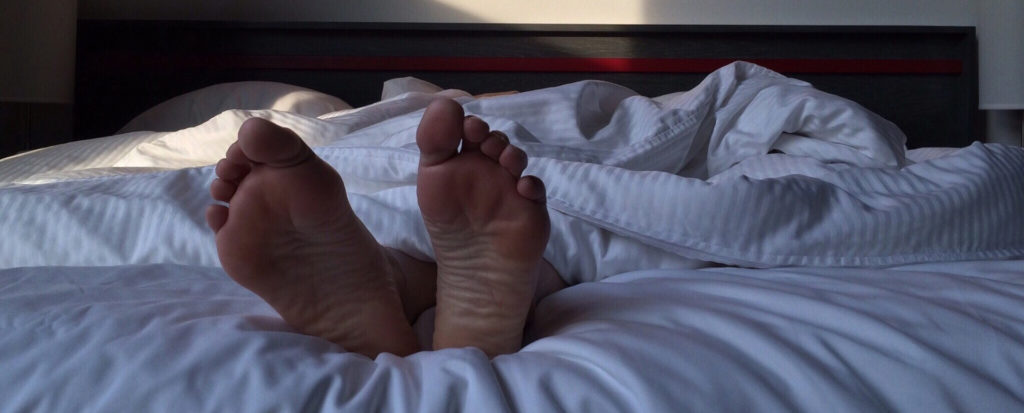
This year’s cold and flu season is unlike any we have experienced before. Specifically, the combination of the annual flu season and the ongoing COVID-19 pandemic means increased focus on personal and community health. In past years, it was common for people to push through cold and flu symptoms at work and school. However, there is a complicated overlap of symptoms between the cold, flu and COVID-19. This makes it confusing to know for sure which illness you have without a test. Because of the importance of limiting community spread, it is critical that you stay home when you have a runny nose, cough, or sore throat that hasn’t been diagnosed. I think it is safe to say that we should not be seeing a repeat of the Michael Jordan flu game this year!
Exercise with Flu – MAYBE
When it comes to exercising while sick, the ‘above the neck’ rule is what we used in the past. In fact, we previously wrote a blog on this topic HERE. In short, if your symptoms were “above the neck” such as a sore throat, runny nose, or congestion, then it was okay to continue to exercise. Conversely, if your symptoms were below the neck, like a deep or hacking cough, fever, upset stomach, and muscle or body aches it was time to stay home and rest. However, this is not the best approach to take when dealing with a possible COVID-19 infection.
Risks of Flu and COVID
While many of the symptoms of flu and COVID are the same, the health risks are quite different. Data and observation of COVID patients in hospitals show an increased risk of myocarditis compared with other viral infections. Myocarditis is inflammation of the heart muscle, which can cause abnormal heart rhythms. It can also limit the ability of the heart to pump blood effectively.
While it seems that most young people who get COVID recover in 5-7 days, there is sometimes a sudden worsening of symptoms during days 7-9. Because of the potential severity of these late-stage symptoms, and the risk of heart damage from myocarditis, doctors recommend full rest and a slow return to activity following a COVID-19 infection.
Exercise with COVID – DON’T
The American Medical Association recommends that very active people who test positive for COVID, but don’t show any symptoms, should rest for two weeks from the date of the test. Athletes who test positive and have symptoms should stop all physical activity for two weeks after all symptoms are gone.
Once the two-week rest period is over, it is important to get clearance from your doctor before returning to activity. This is because of the risk of heart issues. Once cleared, you can start a very gradual return to activity with the supervision of a qualified healthcare professional, like a certified athletic trainer.
Return to Activity
A supervised return to activity should happen over a 5-7 day period. Begin with light cardio, like walking, jogging, or riding a stationary bike. Start by exercising at less than 70% of your maximum heart rate, and not longer than 15 minutes. Over the next 5-7 days, you can gradually increase the duration and intensity of exercise. Each step of the way, you need to complete the activity without any chest pain or tightness, heart palpitations, lightheadedness, or fainting. However, if any of these symptoms do develop, you should go back to your healthcare provider for evaluation before continuing to exercising.
Flu and COVID – Rest is Best
If you have mild symptoms of flu and COVID, but haven’t been tested, you might assume you just have the flu. You might be tempted to push through sickness and continue exercising, especially with mild symptoms. Don’t do it. You may worry about losing hard-earned fitness or letting your team down. Your symptoms might be so mild that you think you are just not that sick. The truth is, the risks outweigh the rewards. In an effort to make minor gains in your fitness, you risk a huge setback from serious illness. In fact, you do more for your future athletic success by sitting out and making a full recovery.
Of course, it is best to do everything you can to avoid getting sick in the first place. Get your flu shot, practice good hygiene, wear your mask, socially distance, eat healthy whole foods, drink lots of water, and get plenty of sleep (Read our blog on the importance of sleep HERE if you missed it).

Written by: Stuart Schmidt, MS, ATC, CSCS athletic trainer supervisor for The Center Foundation in Bend, OR. Learn more about Stuart HERE.
The Center Foundation provides sports medicine services to young athletes at no charge to the students or their families. We do this by placing certified athletic trainers in local high schools to keep kids safe. Learn more about our work HERE.
REFERENCES:
Hull, J., Loosemore, M. and Schwellnus, M., 2020. Respiratory Health In Athletes: Facing The COVID-19 Challenge.
Phelan, D., Kim, J. and Chung, E., 2020. A Game Plan For The Resumption Of Sport And Exercise After Coronavirus Disease 2019 (COVID-19) Infection.
Elliott, N., Martin, R., Heron, N., Elliott, J., Grimstead, D. and Biswas, A., 2020. Infographic. Graduated Return To Play Guidance Following COVID-19 Infection.
https://www.mayoclinic.org/diseases-conditions/myocarditis/symptoms-causes/syc-20352539

 Athletes often search for the newest invention, technique, or ‘secret’ to give them an edge in performance, injury recovery, and injury prevention. While not actually a ‘secret’, there are ways to get an edge that you have direct control over every day. Sleep is one of those elements. In fact, the benefits of sleep for health and performance are powerful, but often overlooked and ignored.
Athletes often search for the newest invention, technique, or ‘secret’ to give them an edge in performance, injury recovery, and injury prevention. While not actually a ‘secret’, there are ways to get an edge that you have direct control over every day. Sleep is one of those elements. In fact, the benefits of sleep for health and performance are powerful, but often overlooked and ignored.


 Schools are resuming in-person sports activities, and our athletic trainers are excited to get back to work protecting young athletes. However, we know that there are concerns about COVID-19. As a parent, it’s natural to be anxious about the safety of your child. For this reason, we want you to know that our team is committed to keeping your kids safe and healthy.
Schools are resuming in-person sports activities, and our athletic trainers are excited to get back to work protecting young athletes. However, we know that there are concerns about COVID-19. As a parent, it’s natural to be anxious about the safety of your child. For this reason, we want you to know that our team is committed to keeping your kids safe and healthy.

 Gavin Thiele was born and raised in Fort Wayne, Indiana. After high school, he left his hometown to attend Purdue University. Gavin enjoyed his time at Purdue and the unique opportunities available to him. In fact, one of his favorite experiences was working as the student intern athletic trainer for the Buffalo Bills.
Gavin Thiele was born and raised in Fort Wayne, Indiana. After high school, he left his hometown to attend Purdue University. Gavin enjoyed his time at Purdue and the unique opportunities available to him. In fact, one of his favorite experiences was working as the student intern athletic trainer for the Buffalo Bills.









 If you can see that the level of damage is deep, covers an area greater than 3 inches, or covers the hands, feet, face, groin, buttocks or a major joint, than you need to call 911 and seek immediate medical care. All third-degree burns as well as some second-degree burns, require immediate medical attention.
If you can see that the level of damage is deep, covers an area greater than 3 inches, or covers the hands, feet, face, groin, buttocks or a major joint, than you need to call 911 and seek immediate medical care. All third-degree burns as well as some second-degree burns, require immediate medical attention.
 COVID-19 disrupted all of our planned activities this spring, including school and organized sports. We all did our part to Stay Home and Save Lives, and many of us have lost some fitness along the way. However, as we move through the phases of reopening, it’s time to get back to fitness as our lives slowly start returning to normal.
COVID-19 disrupted all of our planned activities this spring, including school and organized sports. We all did our part to Stay Home and Save Lives, and many of us have lost some fitness along the way. However, as we move through the phases of reopening, it’s time to get back to fitness as our lives slowly start returning to normal. Make time each day to take care of your body. Whether it’s gentle yoga, light stretching, or a dynamic warm up, maintaining and restoring your range of motion is key to not only preventing injury, but also recovering from injury. Likewise, a little self-massage can bring big benefits. Consider combining both stretching and massage together in your routine. For example, you could use a foam roller or lacrosse ball to work out any tight spots in your muscles, and follow it up with a dynamic warm up or light stretching.
Make time each day to take care of your body. Whether it’s gentle yoga, light stretching, or a dynamic warm up, maintaining and restoring your range of motion is key to not only preventing injury, but also recovering from injury. Likewise, a little self-massage can bring big benefits. Consider combining both stretching and massage together in your routine. For example, you could use a foam roller or lacrosse ball to work out any tight spots in your muscles, and follow it up with a dynamic warm up or light stretching.